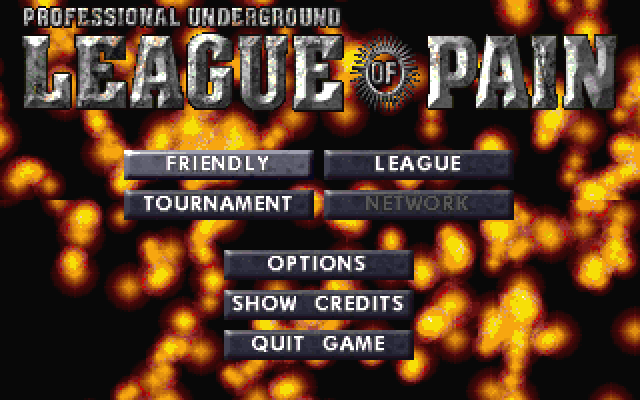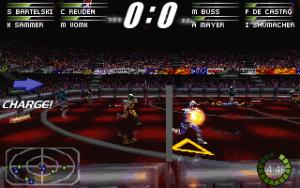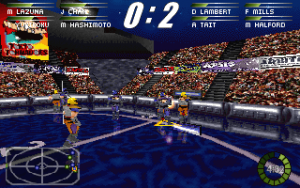Professional Underground League of Pain 
Pop culture seems convinced that we’re going to end up with a violent arena sport in the future. Not just ordinarily dangerous levels of violence like the NFL, but something totally destructive like Rollerball or Zephyr. It makes sense. They’re an exaggeration of our own sports and entertainment (plus a convenient way to stage action in a dystopian setting). We probably won’t get to that point, thankfully, but if we do, it might look a little more like Professional Underground League of Pain.
PULP has a lot of problems, mainly related to the evolution in controls and graphics happening when it was released. But its most insightful fault might be how, even with “Pain” right there in the title, it’s really not so extreme.
The PULP borrows elements from football, basketball, and capture the flag. There’s a single shared goal in the center of the arena. In order to score, a team needs to charge the ball, which looks like a sphere of plasma, and the only place to charge it is in their opponent’s end zone. The team that grabs the ball has to run it to the other side of the court. Then to get a good shot on the goal, they have to fight their way back out of the end zone – literally fighting, punching whoever gets in the way. If the ball drops mid-fight or somebody dashes in and steals it, it’s still charged for your team, so you could still score with it if you get it back fast enough. Depending on how far you throw at the goal from, your team can score up to three points.
The league has all the trimmings of an actual sports league and an actual sports game. There are about a dozen teams hailing from an unusual international selection of cities, like the Frankfurt Vipers and the Tijuana Tyrants. They have player rosters with individual athletes and team strengths. In practice, the teams look and play pretty much the same, but their slightly destructive branding is cool enough to want to get attached to. They’re extreme without being over-the-top, and they fit well into a game that, with competitive league play and commentators barking over the action, acts like this is a real sport.
PULP came out in 1997, an awkward moment when games began to transition from 2D to 3D. The medium was still figuring out the best rules for three-dimensional cameras and controls, and PULP struggles with issues that would be more settled only a few years later.
By default, the game’s camera is positioned at a low angle near center court. The camera will track the ball, but when the ball goes farther out near the end zones, the perspective gets more skewed. Because the game was released before the wide adoption of analog stick controllers, your controls are limited to straight directional movement, and at a low, slanted, distant camera angle, it becomes less intuitive to tell what direction “up” or “left” means. Or how to discern different players in the crowd at a low resolution. If you’ve ever played a PlayStation-era game with dramatic pre-rendered graphics that are difficult to walk through (like one of the Final Fantasy games or Parasite Eve), imagine those rigid controls in a fast sports game.
There are a dozen other camera options. Generally, high-angle cameras against the long side of the court have the clearest perspective without limiting the field of view, but none are perfect. The idea of a moving 3D camera must have still been unfamiliar enough that the developers included the other options as a catch-all.
The game has a clear discomfort with controls in a 3D space meant to fit onto a PlayStation gamepad. The button to charge the ball in the end zone, for example, is the same button to pass. Without a context clue about the right moment to charge up – or a dedicated button for charging – it’s too easy to throw the ball away by accident. The computer opponents don’t have to deal with any of those control peculiarities, like having to line up shots on the goal at a solid 45° or 90° angle, so the game is way harder than intended.
But these are playability issues related to the specific era the game was released in. PULP has a more interesting failing: for all the new rules, combat, and hyped-up metal and fire, it’s still a pretty normal sports game. Although fighting back out of the end zone adds a burst of intensity, the rhythms are still identical to a game of soccer, hockey, or any other sport with a prolonged back-and-forth. One team gets the ball, runs it to the other side, and loses control of the ball, and then play goes back the other way. Compare that to a violent sports game variant like Base Wars or Mutant League Football that stretches the original concept to the point where the athletes straight-up murder each other.
If PULP is as nasty as our future sports will get, then that’s kinda reassuring.
The fights in Professional Underground League of Pain aren’t the game-changing carnage promised by the title. You’re just pushing other players and taking the ball from them. Despite everything going on, it’s still basically soccer.



